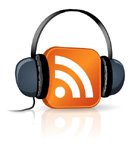 What do you need to produce a podcast show ? Is it just a Mic and a computer with Audacity software or something more ?
What do you need to produce a podcast show ? Is it just a Mic and a computer with Audacity software or something more ?Well, you can definitely create a podcast with the above equipment/software but if you really want people [other than your mom and wife] to listen and subscribe to your podcast feed, you need to go that extra mile. Here are some essential Podcasting tips that you should know to have a finished product which stands apart from the crowd:
1. Always maintain a constant distance between your mouth and the microphone [~3"] so that the sound levels do not vary during the recording process. If the audio is bad, people would delete your feed immediately from their iTunes list.
2. While standalone USB microphones like Samson have a better sound quality than Headset microphones, some people still prefer the latter as they allow them to move their head around while speaking without affecting the recording volume.
3. It is probably a good idea to begin and end your Podcast with some fading music [length ~10 seconds either sides]. You'll find millions of royalty free audio clips in wav/mp3 format on the Internet.
4. A sample rate of 44.1 KHz with 16 bit resolution in either mono or stereo channels is perfect setting for most podcasts.
5. Most audio software have a recording meter that displays the volume level in real time. You may want to maintain the level around the -12db mark for best recording. Don't let it touch the infinite mark.
6. Take some time off for choosing a good podcast webhost. You should consider your average show length and number of subscribers before shortlisting a podcast host.
7. There's still no Adsense like program that will help you make money from Podcasting. Secondly, search engines do not index MP3 files so you should always create proper shownotes [in text] to accompany your blog posts that will bring in the search traffic which may ultimately pay you.
8. While Audacity is the most popular Podcasting software because it is free and has all the required features, professional podcasters may also consider investing Adobe Audition, Soundtrack Pro or Garageband.
9. Online audio interviews can be recorded over Skype using various third-party software or plugins. However, you should consider recording voice of different participants to separate audio tracks or channels to prevent voice overlaps which are otherwise impossible to separate incase of some goofup.
10. Never use sound clips from music albums or hollywood movies as you may seriously run into copyright issues later. There are plenty of sites offering good podsafe music.
I would also suggest that reading this Digital Audio Primer which runs you through basic sound fundamentals like Sampling Rates, Waveforms, Bit Depth, etc. While you can still do podcasting without learning the sound jargon, it would always help if you want to go that extra mile.
And finally, edit your audio mercilessly. Remove all pauses, coughs, fillers ("you know"), uhs and ums as they bore audience and increase the length of your podcast and also the size of the mp3 file. The background music should be very soft so that the main voice over is clearly audible. Some people make that mistake of keeping the background music level either same or even more than the actual podcast host voice which just turns away listeners never to return again.
Always remember that the subscriber has taken too many pains to download your podcast onto his iPod which he would listen on way to office. It's your duty not to disappoint him and present him with that perfect sound which makes him return for future episodes.